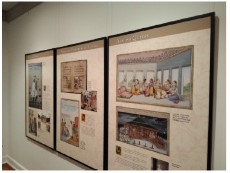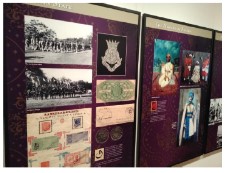By Donovan Harrell, Staff Writer
University Times, the University of Pittsburgh
Note: This article is reprinted with permission from University Times, a Publication of the University of Pittsburgh. Here is the link to the original article in University Times.
The African diaspora is expansive, reaching the Americas, the Caribbean and Europe. But a new University Art Gallery exhibition shows the lives and contributions of members of the African diaspora that are often overlooked: Africans in India.

During the opening reception of “Africans in India: From Slaves to Generals and Rulers†on Feb. 15, the Pitt community heard presentations from Dr. Kenneth X. Robbins, Omar H. Ali and Jazmin Graves, renowned scholars on contributions of elite East Africans in India.
Robbins, the co-curator of the exhibition along with Sylviane A. Diouf, presented an overview of these contributions. He is a psychiatrist, collector, archivist and scholar who specializes in Indian rulers and minority groups.
Ali is the dean of the Lloyd International Honors College and professor of comparative African diasporic history at the University of North Carolina, Greensboro. He’s also the author of “Malik Ambar: Power and Slavery Across the Indian Ocean†(2016, Oxford University Press). Ambar is one of the African rulers featured in the exhibit.
And finally, Jasmine Graves, is a Ph.D. candidate in the department of Asian Languages and Civilizations at the University of Chicago and fellow at the American Institute of Indian Studies.
East Africans, according to the presenters, became generals, admirals, architects, rulers and more. Many of them made their way to these positions after being enslaved. These people were known as Habshis, or Abyssinians, and Sidis.
Upward social mobility for slaves was not common in the transatlantic slave trade. But in the Indian slave trade, Africans who showed intellectual and physical prowess were afforded social mobility.

Ali said that the transatlantic slave trade has dominated the narratives of enslaved Africans in the U.S.
“And that has been shaped, and then … in some ways it’s come to over determine our ability to see Africans as almost anything other than the victims and enslaved subjects,†Ali said. “But I think it’s a function of how we’re taught history, which is very myopic in the United States.
“It’s only been a generation or two where African-American history has been given its proper sort of place in the academy, that mostly Africans and people of African descent have been sort of sidelined in the making of the modern world, which is completely incorrect.â€
This exhibition, Ali said, challenges the dominant narrative of slavery in the U.S. and shows just how vast the African diaspora is.
On loan from the New York Public Library’s Schomburg Center for Research in Black Culture, the exhibit features reproductions of more than 100 paintings and contemporary photos depicting the lives of the Sidis, according to the University Art Gallery. It has been shown at the United Nations and venues on five continents.
Mrinalini Rajagopalan, director of graduate studies in the Department of History of Art and Architecture, and Neepa Majumdar, associate professor of film and media studies in the English department, coordinated the event in partnership with the South Asia Initiative, organized by the Asian Studies Council. Rajagopalan said this exhibit brings attention to the global history of the African diaspora and how it’s affected Indian society.
“It’s a history that’s been really marginalized in Indian history,†Rajagopalan said. “So, it was important for us to really give this exhibition a platform as part of the South Asia Initiative.â€
Majumdar said this exhibition gives the Pitt community an opportunity to dialogue about the complexities of the African diaspora.
“And Pitt is a really important location for Atlantic studies, and we thought because of that, Indian Ocean studies is something we could open up a conversation about the flow of people across the Indian Ocean,†Majumdar said. “And obviously, the African diaspora — usually people think about the Caribbean, the Americas and they don’t think about Asia as much.â€
Accompanying the exhibition is “Movements,†curated by Leslie Rose, a Hot Metal Bridge fellow in art history.
The cases are filled with pieces from Pitt’s permanent collection, including documents, photographs and other artworks related to movements (migration and protests), music and more from other members of the African diaspora.
For Rose, the exhibit offers diverse representation of members of the African diaspora not often seen.
“The importance to me is seeing people,†Rose said of the overall exhibition. “For me personally, as a black woman, seeing people who look like me in spaces that I don’t commonly see.â€
The exhibit was on display between February 15 and March 21. ♠
